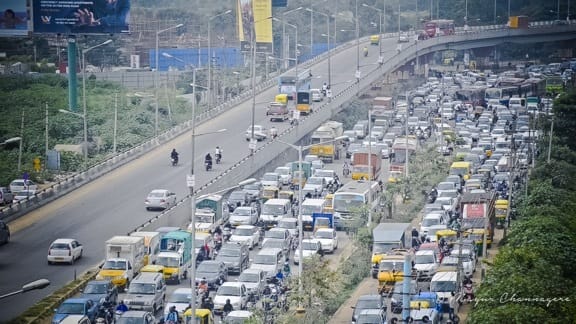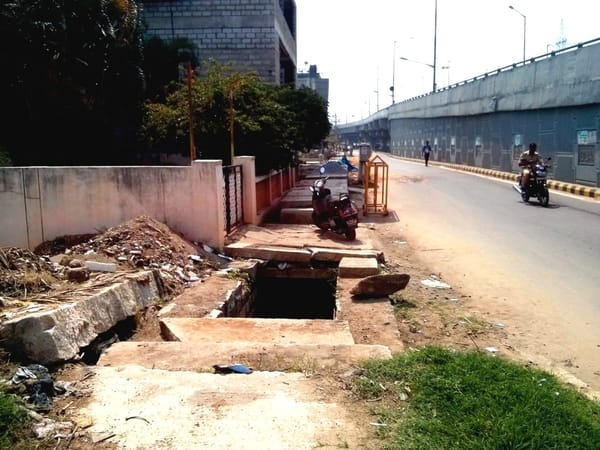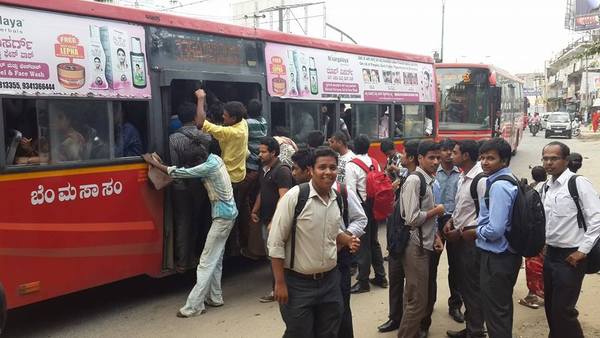In March 2014, Bengaluru In March 2014, Bengaluru Traffic Police conducted a novel experiment. They erected fake cut outs of traffic police in accident-prone areas. This was just one of the ways to beat the staff shortage among police. Despite some folks taking offense, it did get a few nods of appreciation and laughs as well. These cutouts were perhaps a reminder to drivers that there are rules to follow and a body to enforce them.

Traffic on Outer Ring Road on a typical weekday. Pic: Mayur Channagere
In Bengaluru, vehicular traffic has become an economic, environmental and a safety issue. The exponential population growth in the city is not helping. Action must be taken in order to fix these issues.
Here are some things that can be done to make the city’s roads safer.
1. Decongest the road
According to a Bengaluru City Traffic Police report, there are more than 1.5 million vehicles on the road. Of this, personal vehicles alone make up for 90% of the total vehicular traffic. A majority of these vehicles only carry between 1 and 3 people. While cars and bikes may not take up a great deal of space, their multitude is certainly a problem.
While using public transportation or carpooling may seem like the obvious solution to decongesting roads, Bengaluru may just need something more radical. China imposed odd-even driving restrictions in a bid to reduce air pollution and decongest the roads, during the 2008 Beijing Olympics. In March 2015, Paris imposed similar restrictions to combat air pollution, making public transportation free on those days for commuters. Delhi too introduced the odd-even formula on January 1st for a two-week period to curb pollution; the lovely side-effect is that roads are relatively traffic-free, and people are able commute quicker. Even in towns like Mangaluru, odd-even restrictions are in place for select roads with respect to parking. Would something like this work in Bengaluru?
2. Heavier fines for traffic violations
Though there are ample signs calling out various messages like ‘Mind your lane’, ‘Do not drink and drive’, ‘Speed limit 50 km’, etc, oftentimes people ignore them. Currently the fine for dangerous driving ranges between Rs 300 to 500. Drivers need to cough up Rs 300 for speeding and a paltry Rs 100 for using the phone while behind the wheel.
As of now, there is little to no incentive to follow traffic laws with such low fines, especially for drivers with cash to spare. An increase in fine amounts could perhaps act as reason enough for drivers to follow the traffic laws.
3. Curb the drunken driving menace
With Bengaluru’s nightlife getting a new lease of life with the 1 am extension on weekends, the police have upped their checking as well. If an individual has consumed more alcohol than the permissible limit, he/she can be fined up to Rs 2,000 or face six months imprisonment for his/her first offense. The officers are NOT allowed to collect spot fines for drunken driving. However, many a time, offenders get away by bribing the police. This calls for a change on the part of the police, as well as those who drink and drive.
In countries like Germany, getting caught behind the wheel when drunk can most certainly land one in jail, if only for a night. There is also a hefty fine to be paid. The threat of prison time, which may be more of an incentive to not drink, is hardly enforced in Bengaluru.
Our police could perhaps look to Chennai for inspiration. In 2013, Zara, a popular nightclub in Chennai in association with the Chennai traffic police, rolled out a campaign called ‘Drink and get driven’. Drunk drivers who had given their car for valet parking, found Yama, the God of Death from Hindu mythology, waiting in their backseat. Most of them opted to use the drivers-for-hire service following that.
4. Encourage good driving habits
Young drivers quickly abandon their knowledge of traffic laws and follow the poor example of older, more experienced drivers, to reach where they want quickly, with lane weaving, incessant honking, and reckless driving. In order to change the habits of current drivers and end the cycle,Positive Strokes Initiative suggests good driving habits need to be reinforced with positive responses. Positive Strokes suggests that traffic be monitored, and young volunteers take note of Bengaluru’s safe drivers.
5. Utilise technology on the roads
In this Silicon Valley, there doesn’t seem to be a big technological development when it comes to road safety. The use of speed cameras has had huge impacts on the number of accidents in other countries. Bengaluru could install such cameras to monitor the overtaking on pathways by motorists, speeding, and perhaps even curb jumping at signals.
Similarly apps can be used to spot potholes. This is currently being experimented by various groups in the city.
6. Innovative road designs
According to behavioral architectes, FinalMile, much of the issues with dangers on the road stem from human error. FinalMile aims to solve safety issues using effective techniques that deal with the driver instead of the road. One example is the diagonal speed bump. This speed bump, which runs diagonal to the road, rather than perpendicular, forces the attention of the driver back onto the road by causing the car to sway from side to side while passing over the speed bump.
Other technologies, like optical illusions, have been proven to slow down drivers and reduce accidents in dangerous areas.
7. Good walking options for pedestrians

Entire slabs of a footpath in JP Nagar are missing. Pic: Rahul Ravi
The roads are dangerous for drivers and pedestrians alike. Crowded with parked vehicles, piles of trash and construction material, the footpaths which are designed to keep people out of vehicular traffic, are not serving their intended purpose. To make things worse, the footpaths that are clear are utilised by motorcyclists to get ahead of slow moving traffic. Clear footpaths will help pedestrians walk safely.
Many organisations have taken up the initiative to promote safe footpaths and thanks to their efforts, in 2014, the High Court of Karnataka ordered that footpaths be cleared. However, the government mandate doesn’t seem to have had a huge impact just yet.
A study published in the Indian Journal of Medical Research on the magnitude of pedestrian head injuries and fatalities in Bengaluru states that 30-40 percent of road traffic injury victims are pedestrians, and two wheeler vehicles pose the greatest threat to pedestrian lives. A greater availability of crosswalks would provide walkers a safe place to cross the road and prevent more tragic accidents.
8. More public transportation

An almost empty AC bus trails a crowded non-AC bus, even as people struggle to find room. Pic: Naveen Kumar Dahiya
The lack of affordable public transportation can be observed by the overstuffed non-AC buses riding alongside the nearly empty volvo buses. There is a clear disparity in the number of regular buses and volvo buses, the routes they take, and their prices.
The non-AC buses are typically hot and overcrowded, but the AC buses are far too expensive for daily commute. The over-stuffed roads could be relieved if people took buses and metros, but the city has failed to make this option appealing to commuters. Making public transportation more accessible and affordable is the need of the hour.
9. Increase parking spaces
Parking in the city is a challenge, especially in busy areas like Commercial Street, MG Road and Jayanagar 4th block. Cars roam the streets for long periods of time searching for a place to park, adding to the traffic. Providing more parking spaces for the ever-growing number of cars will free up space on footpaths, ease the flow of traffic from weaving around parked vehicles, and keeping drivers’ attention on driving and away from searching for empty spots.
10. More civic engagement and stronger road safety campaigns
Studies show that safety campaigns that use statistics and scare tactics are ineffective. Safety campaigns have to play into people’s emotions in just the right way in order to be effective. On top of signs that give direct and clear messages, safety campaigns need to play into people’s emotions and connect with them on a deeper level than ‘the rules’ do.
The danger of Bengaluru roads has sadly been accepted as part of everyday life. No one enjoys the road conditions, but few attempt to change things. There are several organisations that have made it easy and convenient for city residents to report problems. eSwaraj, Tender S.U.R.E, ichangemycity.com and the Neighbourhood Improvement Programme are all projects that are giving a place for the average citizen’s complaint to be heard and acted upon.
This quirky awareness video by a team of youngsters from Bengaluru captures how people break the rules and what happens later.
A road safety awareness video made by BR Nataraj, BN Chandramouli, Anirudh Shastry and team
Ultimately, it is the citizens of Bengaluru who have to follow the rules, to make road safety a reality.
(With inputs from Ganga Madappa and Shree DN)
Related Articles
The future of road safety in India
If you want to ride pillion in Bengaluru, don’t forget the helmet!
In pictures: Bangalore’s footpaths – An army grade obstacle course!
11th point is whlile approving layouts for private parties, care must be taken to see that link roads to main roads should be left from layout to layout. it is more beneficial if a paralel roads in alignment with with main roads should be carved in upcoming layouts.
I have seen most of the main roads, bannerghatta road, kanakapura roar, mysore road, tumkur road, bellary road , airport road K R puram road, yalahanka road, hosur road and madras road, to name a few, have no parelall roads since layouts are formed without any alignment of roads in between layouts. Lay outs are becoming islands.
town planning should see to it that connected road infrastructure is very important for smooth flow of traffic.